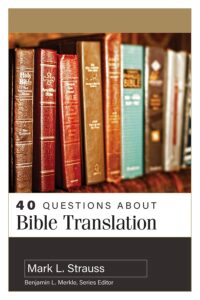How should gender language be handle in Bibles? Are some translations liberal and others conservative? Is it okay that I like some versions and not others? Why are Bible translations often so different? Which ones are most accurate? Isn’t a literal translation always the best?
Reading and studying the Bible has been a revered practice for centuries. Yet often we take for granted that it is there, not realizing the complex and fascinating process involved in making it available. Mark Strauss, who has been involved in many translation projects, pulls back the veil on all this in 40 Questions About Bible Translation, a book that models clarity and good sense. His volume is packed with so much helpful information that it is hard to summarize.
 Translation begins with finding the oldest and best ancient manuscripts from earlier centuries. While most scholars agree, even in this a minority don’t, and that can lead to differences.
Translation begins with finding the oldest and best ancient manuscripts from earlier centuries. While most scholars agree, even in this a minority don’t, and that can lead to differences.
Then, besides knowing Greek and Hebrew, translators must know ancient cultures and how they used language and figures of speech. Consider, for example, how translations sometimes render phrases in ordinary language and sometimes don’t:
♦ “If he is alone, there is news in his mouth” meaning “he brings good news” (2 Samuel 18:25 ESV/NET)
♦ “Putting everything under his feet” meaning “under his authority” (Psalm 8:6 NASB/TLB)
♦ “I send My messenger before your face” meaning “ahead of you” (Mark 1:2 NKJV/NIV)
♦ “Having lived with her husband seven years from her virginity” meaning “after her marriage” (Luke 2:36-37 KJV/NASB)
♦ “His father . . . ran and fell on his neck” meaning “he hugged him” (Luke 15:20 ASV/CEB)
Strauss offers many such examples throughout the book to help us understand how Bible translators go about their important work.
Another reason for many of these differences in Bibles is the philosophy of translation. All “versions agree on two fundamental goals of translation, accuracy and readability” (p. 22). But it is nearly impossible to do both 100%. So some translations will aim primarily at accuracy (preserving the original language as much as possible), and others primarily at readability (making it understandable to current readers), while a third group tries to find a happy medium between the two.
We might think that word-for-word translation would be the best option, but often it is not. A literal word-for-word translation of Romans 7:23 would read, “I see but another law of members in me.” Yet no translation reads like this. If readers are confused, then the meaning is not communicated accurately. All versions, therefore, mix a word-for-word approach with readability to some degree or another. As a result, no translation is or can be literal.
Another challenge translators face is that a single Greek or Hebrew word can have multiple meanings. To illustrate, Strauss considers some meanings of the one English word board (see pp. 85-86):
A flat piece of wood (n.)—“Saw that board in half.”
A control panel (n.)—“Check the circuit board.”
A leadership team (n.)—“The board voted on new officers.”
Various flat surfaces (n.)—“skateboard,” “surfboard,” “blackboard”
Daily meals (n.)—“Does that include room and board?”
To get on a vehicle (v.)—“It’s time to board the plane.”
So a judgment call (that is, an interpretation) is always made on which meaning is intended for a particular Greek or Hebrew word, usually based on context.
 While the differences in Bible versions can be confusing, it’s important to remember the advantages. It means we have a variety of translations well suited for different purposes–some for public reading, some for study, and others for devotional reading. In addition, if we come across phrases like “holy kiss,” “with . . . a double heart,” “make their ears heavy”—we may be left a bit befuddled. By comparing different translations, we can sometimes get a better sense of the range of meanings in a text. 40 Questions charts dozens of translations along a continuum to show how they each wrestle with the balance of accuracy and readability in different ways.
While the differences in Bible versions can be confusing, it’s important to remember the advantages. It means we have a variety of translations well suited for different purposes–some for public reading, some for study, and others for devotional reading. In addition, if we come across phrases like “holy kiss,” “with . . . a double heart,” “make their ears heavy”—we may be left a bit befuddled. By comparing different translations, we can sometimes get a better sense of the range of meanings in a text. 40 Questions charts dozens of translations along a continuum to show how they each wrestle with the balance of accuracy and readability in different ways.
Space doesn’t allow me to mention all the interesting factors that go into translation which Strauss explains with such finesse. Just a few of the other topics he addresses include:
♦ The strengths and weaknesses of different translation philosophies
♦ How different ancient copies of Bible books help in translation
♦ Why there have been so many different translations over the centuries
♦ What has happened with gender language in the Bible over the last thirty years
Given how much is packed into this volume, it is now the basic go-to resource for what’s behind Bible translations.
—
*Disclosure: I received a complimentary copy of the book from the publisher. My opinions are my own.
Image: Peachknee on Pixabay
